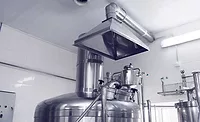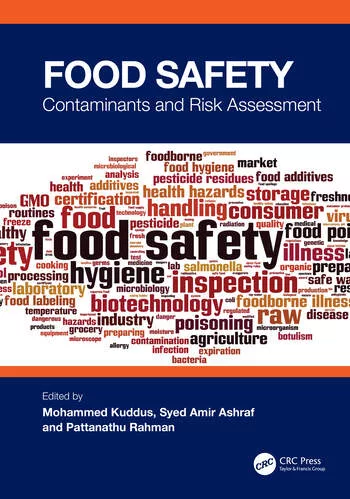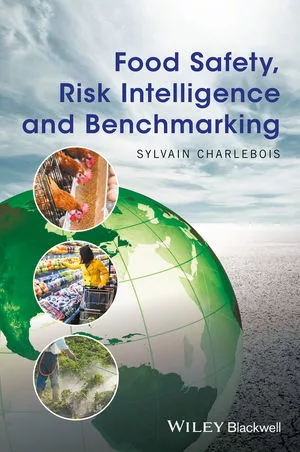Risk of Oligodynamic Silver Use in Food Preservation and Processing Operations

Complex regulatory processes are involved with defining food substances and whether they are allowed for inclusion in foods intended for human use. European and U.S. regulatory authorities primarily approach regulation development from a scientific basis, using toxicokinetics assessments and expert reviews to promulgate food additive regulations. For food safety, the U.S. Environmental Protection Agency (EPA), U.S. Food and Drug Administration (FDA), European Food Safety Authority (EFSA) and Codex Alimentarius Commission (Codex) are the leading developers of standards and regulations related to substances allowed in human food. Toxicokinetics inclusive of exposure assessment, toxicity, and reproductive and molecular toxicology, are integral to the risk assessment process. This report summarizes the findings from the literature to determine the toxic effects of silver and confirm the regulatory framework under which silver is approved as a food additive.
Silver does not occur regularly in animals or humans but is present in air, water, soil and food. The average concentration of silver in water is 0.5 ppb, while its concentration in soil is approximately 10 ppb.[1] EPA lists silver as a Group D carcinogen (i.e., not carcinogenic in humans)2 and established an oral reference dose at a daily intake limit of 0.005 mg/kg. According to EPA, “minimal dietary exposure may result from the use of silver in human drinking water systems.”[2]
A Closer Look at Silver
According to FDA, silver is a nonessential mineral that has no known physiological benefits when taken orally.[3] Silver is found in many foods and naturally occurring water.[4] One of the earliest studies on silver content in foods was conducted in 1940 by Kehoe.[5] This study reported that an average daily intake of fruit and vegetables would provide between 50 and 100 µg of silver as a trace element. Dietary exposure is approximately 90 µg/day.[6–8] Based on EPA’s reference dose, the maximum daily exposure to silver should be less than 350 µg.[9,10] The World Health Organization Guidelines for Drinking Water Quality[11] established a lifetime oral intake of about 10 g of silver. EFSA has accepted this exposure level as the basis of the human “no observed adverse effect level” (NOAEL) for silver in the diet.[12] An EFSA panel suggested that a restriction of 0.05 mg silver/kg of food would limit intake to less than 13 percent of the human NOAEL, assuming that each day a kilogram of food is consumed containing silver at this limit.[13–15] These various standards and threshold values were established out of concern for preventing the risk of argyria, a condition that turns skin blue as a result of overexposure to silver’s chemical compounds.
Although silver itself is not considered toxic, most of its salts are poisonous.[16] Silver’s biological half-life ranges from a few days in animals to up to about 50 days in humans.[17] While it is poorly absorbed from the intestine,10 its salts may be absorbed by up to 10–12 percent following ingestion.[6,7,17] East et al.[18] showed an absorption rate in humans of 18 percent. Silver is not extensively metabolized in mammals, which may contribute to its low degree of toxicity.[19] The risks from silver itself may be mitigated by the tendency of the silver ion to form strong complexes, which are of very low bioavailability and toxicity.[20]
The toxic effects of silver in humans manifest in several forms—some proven, others suspected. Proven forms include argyria, gastrointestinal irritation and renal and pulmonary lesions. Suspected forms include ill-defined arteriosclerosis.[21–23] An oral dose of 10 g of silver nitrate (AgNO3) is fatal in humans[24,25] as is the therapeutic intravenous administration of more than 50 mg of silver.[17]
Silver ion is a very toxic substance as a metabolic inhibitor of lower life forms. Biochemically, the silver ion acts as an enzyme inhibitor.[26] According to one study, “ionic silver is unique in comparison with other antibiotics in that it has no toxicity and carcinogenic activity.”[27] Silver ion is a disinfectant for nonspore-forming bacteria, such as Salmonella spp., Staphylococcus and Escherichia coli, at concentrations about 1,000 times lower than the levels at which it is toxic to mammalian life.[27] This extreme mammalian-to-bacterial toxicity differential is the definition of an oligodynamic material.
Colloidal silver has been known for more than 100 years.[28] Before the invention of penicillin in 1928, colloidal silver was used to treat many infections and illnesses.[29]
Colloidal silver is generally produced by electrolysis when an electric current is passed through a series circuit consisting of a silver electrode and deionized water. The current flow causes Ag (metal) and Ag+ (ion) to migrate from the electrode into the deionized water.[30] Silver colloids produced via electrolysis will generally contain more than 75 percent ionic silver. Berger et al.[31] determined the bacteriostatic and bactericidal concentrations of electrically generated silver against 16 clinical isolates and standard test organisms. The inhibitory and bactericidal concentrations of electrically generated silver ions were 10 to 100 times lower than that for silver sulfadiazine. Effects on normal mammalian cells were minimal.[31] The European Union (EU), through Codex, has officially banned colloidal silver as a food material. The material can no longer be sold as a dietary supplement in health food stores within the EU.[32,33] The ban was established due to an absence of toxicological data supporting the safety of colloidal silver in dietary supplements. The ban also appears related to the emergence of nanosilver materials and their proliferation as colloidal compounds. The literature review did not find an occurrence of adverse health effects associated with exposure to colloidal silver compounds in either the EU or U.S. Colloidal silver proteins with low silver content (1–6 ppm) are sold in the U.S. as health food products.
From a regulatory perspective, silver’s status as a food additive is ambiguous. The one clear fact is that silver is not listed as a banned or prohibited substance by either U.S. or EU regulations. It is used in food processing as a color additive and processing aid. Likewise, silver has been approved as an indirect additive by both FDA and EFSA. It is approved by EPA and Canadian authorities for use in treating public potable water supplies. However, silver is not officially approved for direct addition to food.
Silver has long been recognized as a therapeutic agent, used topically in skin creams and wound dressings, neonatal eye drops and medical instruments. Oral medications that contain forms of silver include antismoking lozenges and breath mints. As an indirect food contact substance, silver is found in many products, including pesticides for use in or on foods, cutlery and cooking utensils, food containers and cookware, and in food packaging.[23,34] It also has a long history of use in materials that have been used as food or food ingredients.
Pertinent regulatory approvals include:
• FDA-approved silver solutions in the 1920s to be used as antibacterial agents4
• Registration of silver as a pesticide in the U.S. in 1954 for use in disinfectants, sanitizers and fungicides
• In 1991, EPA replaced the Primary Drinking Water Standard of 50 µg silver/L with a secondary maximum contaminant level of 100 µg silver/L in potable water supplies
In the U.S., there are about 80 EPA-registered pesticide products that contain silver as an active ingredient. The vast majority (90%) of the registered products are approved for use in water filters to inhibit the growth of bacteria in municipally treated tap water.[9]
Silver ion is approved in Australia as a processing aid for packaged water and for water intended for inclusion in other foods in Section 1.3.3 of the Australian/New Zealand Food Standard Code.[35]
Silver is approved by Codex and EFSA as a color additive for use in human food and beverages.[36]
Antimicrobial Activity of Ionic Silver
The antimicrobial properties of silver have been known for centuries, and various civilizations have exploited this property of the metal. However, there has been renewed interest in silver as a broad-spectrum antimicrobial. In particular, it is being used with alginate, a naturally occurring biopolymer derived from seaweed, in a range of silver alginate products designed to prevent infections.
In terms of antifungal properties, silver is reported to be the most effective.[37] Contact time, temperature and pH are said to impact the rate and extent of its antimicrobial activity.
Silver’s antimicrobial activities are broad. It is clear from research that bacteria, yeasts, molds and, to a lesser extent, viruses are generally susceptible to the oligodynamic actions of silver, silver ions and assorted silver compounds and complexes. Food spoilage microorganisms and human pathogens have been shown susceptible to its lethal effects.
Minimum inhibitory concentrations (MICs) and minimum bacterial concentrations (MBCs), as well as D-values, are reported for a wide range of microorganisms. There is significant discrepancy in the reported MICs by microorganism. This may be a manifestation of the differences in methods used in developing the MICs. The MICs for silver generally compare with those for potassium sorbate and sodium benzoate. There appears to be better agreement on MBC values for yeast, molds and bacteria.
The microbiocidal activity of Ag+ and AgNO3 were studied by Simonetti et al.38 These researchers conducted silver-inactivation studies at 25 °C and pH 6.5 using 10-5 and 10-6 M solutions of Ag+ and AgNO3. The D-values (time required to achieve a 90% reduction in viable count) generated from this work are presented in Table 1.[38]
Table 2 provides MIC and MBC data for seven foodborne pathogens.[39] The isolates reported in the table were obtained from various food matrices and challenged with colloidal silver nanoparticles. These researchers concluded from the data that nanocolloidal silver exhibited a good bacteriostatic effect but a poor bactericidal effect.

Mechanism of Inactivation
Silver ions clearly do not possess a single mode of action in delivery of lethal effects. Ionic silver interacts with a wide range of molecular processes within microorganisms, resulting in effects ranging from inhibition of growth and loss of infectivity to cell death. Toxicity to microbial cells is exhibited at very low concentrations. Petrus et al.[39] in their work with foodborne isolates concluded that nanocolloidal silver was an excellent bacteriostatic but poor bactericidal agent.
The kill kinetics vary, depending on the source of the silver ions. In microbiological challenge studies with ionic silver and silver nitrate, for example, in 2010, Assar and Hamuoda reported the ionic form was effective against yeast and filamentous mold, whereas the silver compound (AgNO3) was not. The mechanism of inactivation appears to depend on both the concentration of silver ions present and the sensitivity of the microbial species to silver.[40] There are several schools of thought as to the precise mechanism involved with its lethal effects: Some researchers report that it is membrane-dependent, while others maintain that it has to do with DNA binding. Silver ions have been demonstrated to interact with the proteins and possibly phospholipids associated with the proton pump of bacterial membranes.[41] With regard to DNA binding, it has been reported that silver binds DNA, preventing its replication and ultimately resulting in cell death.[27]
Silver has also been shown to act synergistically with hydrogen peroxide and saponins isolated from cayenne. Rivardo et al.[42] reported an increase in silver’s activity against E. coli biofilms when it was used in concert with a lipopeptide biosurfactant. Similar findings resulted when silver nanoparticles were combined with fluconazole and used against pathogenic fungi.[43]
It is also important to note the relative absence of contributions to the microbiological literature on the sporicidal (bacterial) effects of silver. Vegetative forms of Bacillus cereus, Bacillus subtilis and Bacillus licheniformis have been shown to be susceptible to silver. The data on spores of these organisms were not sufficient to allow commentary on the use of ionic silver for inhibiting spore germination, inhibition or inactivation. However, it is abundantly clear that silver in its many forms, and especially ionic silver, has a long and well-documented history of efficacy as an antimicrobial agent.
Conclusions
Based on the food safety risk assessments conducted, there remain a number of vagaries, unanswered questions and outright disagreement among experts and regulatory officials about certain aspects of the safe use of silver ions in foods or in direct contact with foods that are intended for human use. By contrast, it appears that there is abundant, excellent science supporting the safe use of this oligodynamic metal for disinfection and sanitization of food processing equipment, food contact surfaces and other vulnerable areas within the food factory. The emergence of antibiotic-resistant strains of human pathogens in the food supply is a great source of concern for food safety scientists and public health officials. Bringing new materials and compounds, such as Ag+, to the fight against foodborne disease is vital for preserving public health. However, it is also imperative to confirm the safety of such materials prospectively. Knowledge of risk assessment strategies and techniques, for silver and other substances, is the future of food safety.
Larry Keener, CFS, PCQI, is president and CEO of International Product Safety Consultants.
References
1. Newton, DE. Chemical Elements: From Carbon to Krypton, 2nd ed. (Farmington Hills, MI: Gale, 2006).
2. archive.epa.gov/pesticides/reregistration/web/pdf/4082fact.pdf.
3. www.fda.gov/food/recallsoutbreaksemergencies/safetyalertsadvisories/ucm184087.htm.
4. Tips, S. 2003. “Silver Facts Outshine the FDA.” Whole Foods Magazine October:56–57.
5. Kehoe, RD et al. 1940. “A Spectrochemical Study of the Normal Ranges of Concentrations of Certain Trace Metals in Biological Materials.” J Nutrit 19:579–592.
6. Tripton, IH et al. 1966. “Trace Elements in Diets and Excreta.” Health Phys 12:1683–1689.
7. Hamilton, EI and MJ Minaki. 1972. “Abundance of Chemical Elements in Man’s Diet and Possible Relations with Environmental Factors.” Sci Total Environ l:375–394.
8. Clayton, GD and FE Clayton. Patty’s Industrial Hygiene and Toxicology, 3rd ed. (New York: Wiley, 1981).
9. U.S. EPA. 1991. National Secondary Drinking Water Standards. Office of Water, EPA 570/
9-91-019FS.
10. ec.europa.eu/health/archive/ph_risk/committees/scmp/documents/out30_en.pdf.
11. www.who.int/water_sanitation_health/publications/gdwq4-1st-addendum/en/.
12. onlinelibrary.wiley.com/doi/10.2903/j.efsa.2007.555/abstract.
13. www.contactalimentaire.com/fileadmin/ImageFichier_Archive/contact_alimentaire/Fichiers_Documents/Avis_de_AESA/avis_AESA_04_liste_ang.pdf.
14. Council of Europe. 2008. “Guidelines on Metals and Alloys Used as Food-Contact Materials.” RD 4/1-48.
15. onlinelibrary.wiley.com/doi/10.2903/j.efsa.2011.1999/pdf.
16. cfpub.epa.gov/si/si_public_record_report.cfm?dirEntryId=226785&fed_org_id=770&SIType=PR&TIMSType=Published+Report&showCriteria=0&address=nerl/pubs.html&view=citation&sortBy=pubDateYear&count=100&dateBeginPublishedPresented=01/01/2010.
17. Fowler, BA and GF Nordberg. “Silver,” in Handbook on the Toxicology of Metals. Friberg, L, GF Nordberg and VB Vouk, eds., vol. II (Elsevier, 1986), 521–531.
18. East, BW et al. 1980. “Silver Retention, Total Body Silver and Tissue Silver Concentrations in Argyria Associated with Exposure to an Anti-Smoking Remedy Containing Silver Acetate.” Clin Exp Dermatol 5:305–311.
19. images.library.wisc.edu/EcoNatRes/EFacs/Argentum/Argentumv03/reference/econatres.argentumv03.jubergreview.pdf.
20. www.nanotechproject.org/inventories/silver.
21. Casarett, LJ and J Doull. Toxicology: The Basic Science of Poisons (MacMillan, 1975), 967–969.
22. Greene, RM and WPD Su. 1987. “Argyria.” Am Fam Phys 36:151–154.
23. ATSDR. 1990. “Toxicological Profile for Silver.” U.S. Department of Health and Human Services, Public Health Service, Agency for Toxic Substances and Disease Registry (TP-90-24), Atlanta, GA.
24. Cooper, CF and WC Jolly. 1970. “Ecological Effects of Silver Iodide and Other Weather Modification Agents: A Review.” Water Resour Res 6:88–98.
25. Faust, RA. 1992. “Toxicity Summary for Silver.” Oak Ridge National Laboratory.
26. Chambers, J et al. 1974. “Silver Ion Inhibition of Serine Proteases: Crystallographic Study of Silver-Trypsin.” Biochem Biophys Res Comm 59:70–74.
27. Batarseh, KI. 2004. “Anomaly and Correlation of Killing in the Therapeutic Properties of Silver (I) Chelation with Glutamic and Tartaric Acids.” J Antimicrob Chemother 54:546–548.
28. www.accessdata.fda.gov/scripts/fdcc/index.cfm?set=IndirectAdditives&sort=Sortterm_ID&order=ASC&showAll=true&type=basic&search=.
29. www.colloidalsilvers.org/colloidal-silver/nano-silver/.
30. www.silver-colloids.com/Papers/CSProperties.PDF.
31. Berger, TJ et al. 1976. “Electrically Generated Silver Ions: Quantitative Effect on Bacterial and Mammalian Cells.” Antimicrob Agents Chemother 357–358.
32. BfR. 2009. “BfR Recommends that Nano-Silver Is Not Used in Foods and Everyday Products.” BfR Opinion Nr 024/2010. Germany. 28 December.
33. 12160.info/profiles/blogs/codex-alert-colloidal-silver.
34. Howe, PD and S Dobson. Silver and Silver Compounds: Environmental Aspects (Geneva, Switzerland: WHO, 2002), 50.
35. www.foodstandards.gov.au/code/Documents/1.3.3 Processing Aids v144.docx.
36. European Commission. 1994. European Union Directive 94/36, Annex IV. “European Parliament and Council Directive 94/36/EC of 30 June 1994 on Colours for Use in Foodstuffs.” Official Journal, L 237, 10/09/1994, 0013–0029.
37. www.ncbi.nlm.nih.gov/pmc/articles/PMC3385153/.
38. www.ncbi.nlm.nih.gov/pmc/articles/PMC183190/pdf/aem00053-0060.pdf
39. www.ifrj.upm.edu.my/18%20(01)%202011/(6)%20IFRJ-2010%20Petrus[1].pdf.
40. Assar, NH et al. 2010. “Colloidal Silver as a New Antimicrobial Agent.” Int J Microbiol Res 1:33–36.
41. Dibrov, P et al. 2002. “Chemiosmotic Mechanism of Antimicrobial Activity of Ag+ in Vibrio cholerae.” Antimicrob Agents Chemother 46(8):2668–2670.
42. Rivardo, F et al. 2010. “The Activity of Silver against Escherichia coli Biofilm Is Increased by a Lipopeptide Biosurfactant.” Can J Microbiol 56(3):272–278.
43. Gajbhiye, M et al. 2009. “Fungus-Mediated Synthesis of Silver Nanoparticles and Their Activity against Pathogenic Fungi in Combination with Fluconazole.” Nanomedicine 5(4):382–386.
Looking for quick answers on food safety topics?
Try Ask FSM, our new smart AI search tool.
Ask FSM →









